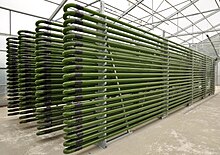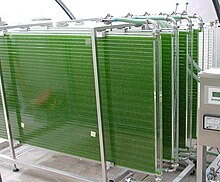Algae reactor
An algae reactor or algae bioreactor is a photobioreactor for the cultivation of algae into which carbon dioxide (CO 2 ) is introduced. The growing algae use the CO 2 and sunlight made available to them to carry out photosynthesis . The advantages of cultivating microalgae ( phytoplankton ) compared to cultivating useful plants on land are the high yield per area as well as the absence of waste such as roots and lower water consumption. In addition, they are not in competition with land plants. The disadvantages are the high costs and the lack of large-scale industrial processes. Using it for the production of bioenergy is not yet economical. The use for the production of food supplements, pharmaceuticals and cosmetic products is already taking place.
species
The most commonly used classes are Cyanophyceae (blue and green algae), Chlorophyceae (green algae), Bacillariophyceae (diatoms) and Chrysophyceae (golden algae). The dominant genera in commercial production are Isochrysis (golden-brown flagellate Prymnesiophyceae ), Chaetoceros (diatom), Chlorella (unicellular green algae - fresh water), Arthrospira ( spirulina - cyanobacteria (blue algae)) and Dunaliella (unicellular green algae - salt water).
use
Microalgae from reactors, dried and ground, can serve as heavy metal filters, which can be cleaned more thoroughly than activated carbon and are reusable. For substances that can antifouling paints and medicines derived from pathogenic viruses and bacteria. A pilot plant for biomass production from Eon Hanse is located in Hamburg-Reitbrook .
CO 2 fixation
The microalgae fix the carbon dioxide from power plant emissions and use it as a carbon source. The production depends on the solar radiation, so that there are strong seasonal differences in temperate latitudes. Furthermore, the space requirement is problematic and a pumping operation with the airlift method is energy-intensive.
Fuel production
So-called third-generation biofuels are cultivated plants that do not take away any land from food production, as they can also be cultivated where agriculture is not possible (e.g. semi-deserts). Some microalgae (e.g. Prymagnesium parvum , Scenedesmus dimorphus ) are being tested for use for oil production because they have high oil contents. The problem is that the algae only store their energy in the form of oils in the stationary phase of growth. Milking the algae without destroying them is also difficult. The algae have to be centrifuged and filtered to harvest, as their small size does not allow them to settle on their own. Only the dry matter can be processed further, and drying is also energy-intensive. A cost-covering production is currently not in prospect.
Hydrogen production
Under stress conditions such as lack of nutrients, the green alga Chlamydomonas reinhardtii converts protons into hydrogen with the help of the enzyme hydrogenase using electrons produced during photosynthesis . The advantage is that the processes run at normal ambient pressure and temperature. The system costs are therefore low and the substrate, mainly water, is cheap and renewable. The process is CO 2 neutral. In addition, hydrogen is generated which, compared to that from other gasification processes, has significantly fewer undesirable accompanying substances such as B. contains hydrogen sulfide (H 2 S), alkalis or dust. In contrast to an in vitro system, however, the yield is very low.
food
The use of some types of algae as food seems to be the most promising of all possible uses. The freshwater algae Chlorella contains z. B. the minerals calcium, magnesium, zinc, iron, selenium as well as all essential amino acids and numerous unsaturated fatty acids . It can be used as a dietary supplement due to its diverse health-promoting effects.
See also
Web links
- European Society of Microalgal Biotechnology ( Memento from February 20, 2010 in the Internet Archive )
- Learning unit: algae reactor
Individual evidence
- ↑ a b c d e f g Microalgae - How can they be used for CO2 fixation, biomass and biofuel production or hydrogen production? ( Memento from July 21, 2009 in the Internet Archive )
- ↑ Hamburg microalgae project ( Memento from January 11, 2012 in the Internet Archive )
- ↑ Christine Rösch, Juliane Jörissen, Johannes Skarka and Nicola Hartlieb: Ways to reduce land use conflicts. In: TECHNOLOGY IMPACT ASSESSMENT - Theory and Practice, hrgg. from the Institute for Technology Assessment and Systems Analysis (ITAS), No. 2 - Focus: Land Use Conflicts - Causes, Consequences and Approaches to Solutions, Volume 17 - September 2008, pp. 66–71.
- ↑ Hydrogen from the test tube: Bochum researchers use the green algae hydrogen factory


